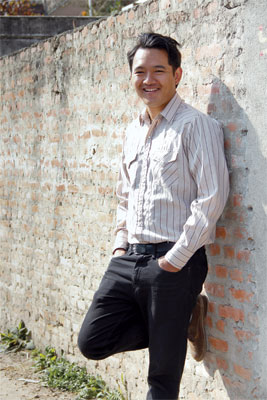Ithaca is a small town. In the winter, there’s really not much to do but to stay inside and work on things. For artists and musicians, it’s a good thing, allowing a seclusion that helps them focus on their work.
For Diwas Gurung, the settings work. He has a lazy lifestyle he admits, as we catch up at Thamel’s Chikusa Café on a few years of his life in the US as a musician and now increasingly as a frontman too. But one would beg to differ given the quantity of work he’s doing, composing music with his new band Photoreal as well as numerous Nepali folk songs. He played a few of these at a quiet charity show in Lazimpat’s Asian Village restaurant to an audience that seemed a little confused by his approach to folk classics.
 To understand this approach, it would be easy if one understood the components that seemingly make up Gurung’s musical personality. Diwas Gurung grew up on grunge and alternative rock while in school. By high school, he was belting out adequate covers of artists as diverse as Pearl Jam, Jimmi Hendrix and Tracy Chapman. Fresh out of high school, he joined the metal band Albatross and was instrumental in their underground hit album Hi: Fly. At Ithaca College where he studied and earned a degreee in Economics, he became a part of Ayurveda with whom he toured extensively and produced multiple albums.
To understand this approach, it would be easy if one understood the components that seemingly make up Gurung’s musical personality. Diwas Gurung grew up on grunge and alternative rock while in school. By high school, he was belting out adequate covers of artists as diverse as Pearl Jam, Jimmi Hendrix and Tracy Chapman. Fresh out of high school, he joined the metal band Albatross and was instrumental in their underground hit album Hi: Fly. At Ithaca College where he studied and earned a degreee in Economics, he became a part of Ayurveda with whom he toured extensively and produced multiple albums.
While most people in Nepal know Gurung as the singer and guitar player who came up with the charming folk-covers album Rato Mato, Gurung is more popular in the US as the talented guitar player for progressive rock band Ayurveda. “I think we hit a plateau with Ayurveda,” says Gurung. While their sound changed with each Ayurveda album, Diwas felt like they were starting to get repetitive. He had already been playing a few Nepali folk numbers here and there at their shows and even though the American audience members at their shows didn’t get the lyrics, they always seemed to enjoy the music. This along with the increasing influence of Nepali folk music that his father sent to him on tape got Gurung increasingly into composing and playing a genre he called neo Nepali folk music.
Lately he’s been making music with Photoreal, the new band he’s formed with the bassist and drummer of Ayurveda. With his new band Gurung is going for an aural-visual combination that will add to the shows they hope to do. By bringing in his history of playing rock, blues, metal, progressive and now electronic music into the studio when he works on folk music, his apprach is fresh, something that brings otherwise reluctant Nepali youth to folk music shows. n











